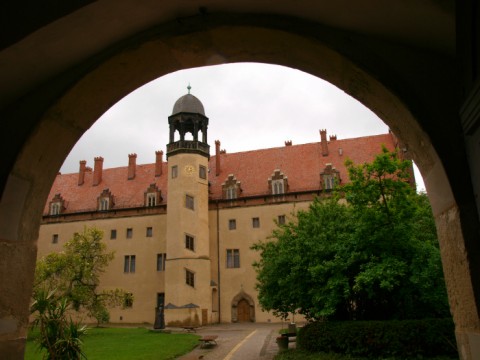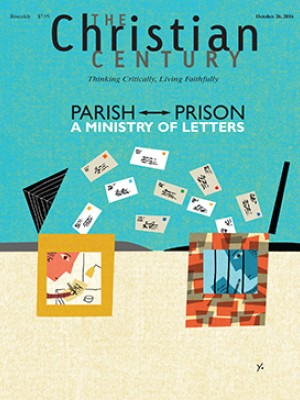
Wittenberg is a two-street, two-church town. In the middle is St. Mary’s, the “City Church.” The internal decorations were destroyed by the iconoclasm of 1522, and it still feels austere. Its masterwork is a later altarpiece by local Lucas Cranach. It shows layman Philip Melanchthon baptizing an infant while Martin Luther preaches and holds the keys of the confessional—that emblem usually found in apostle Peter’s hands. The center panel assembles Jesus and his disciples around the Last Supper—a rare theme in medieval art, one given new life by the Reformation.
The most striking scene of all, however, is painted across the bottom: a congregation of 16th-century burghers listens to Luther preaching. The painting represents the heart of preaching: Luther directs the gaze of his congregation toward the figure of Christ crucified, hanging between them.
Read our latest issue or browse back issues.
And at the far end of town is All Saints, called the “Castle Church,” as it is attached to the elector’s castle. Its tower is capped by a conspicuously regal crown inscribed with the words “A Mighty Fortress Is Our God.” Luther’s tomb is here beneath the pulpit, opposite that of his friend Melanchthon. It was on this church’s wooden door, in the path of student traffic, that Luther purportedly posted his 95 theses.
The present door pays tribute to the event, its tarnished bronze heft inscribed with all of the theses, looking rather like Moses’s two tablets of the law. One legend says the new door was needed because the old one kept getting chipped away by the faithful. In truth the whole church burned down in the 18th century, but I rather like the idea of Protestant pilgrims taking home their piece of “the true door.”
In a way this legend isn’t too far from the truth, for it’s obvious that Wittenberg has become a city-sized shrine to Luther—and to his colleagues Melanchthon, Johannes Bugenhagen, and a few others. But mostly to Luther. It wasn’t always this way, though. Travelers of the 19th century lamented that Luther’s house was a dump, the university had moved to neighboring Halle, and the whole town was rather miserable. It’s clearly not what the likes of Harriet Beecher Stowe expected to find when in the 1850s she visited what she and others deemed the “Protestant Mecca.”
For a long time Wittenberg lay forgotten, pieces of the true door notwithstanding. It never had been a great city like Rome or even nearby Leipzig or Erfurt. The only real fame it ever had came from Luther, from the fact that for a little while in the 16th century it was the center of the Reformation.
In the past few decades the city, now renamed Lutherstadt Wittenberg after its patron, has been completely cleaned up, renovated, and readied for the throngs of visitors streaming in to honor Germany’s most famous figure. The erstwhile dust-filled Lutherhaus (originally the Augustinian cloister to which Luther belonged) is now a very nice museum. Besides delivering a thorough introduction to the Reformation, it offers spine-tingling proximity to Luther artifacts: his handwritten notes, his black academic gown, the pulpit from which he preached, and even officially stamped and sealed letters of indulgence.
But we don’t see the Wittenberg Luther saw. Even his house has been completely reconstructed. Five hundred years is long enough that archaeologists were needed to identify Luther’s former study. The foundation of the building is on display, under glass, the old cellars dug up and looking less like an early modern house than the ruins of Pompeii.
It’s a stroke of luck that there was a Wittenberg left to excavate at all. Despite its nearness to arms-producing factories, Wittenberg was largely spared the bombing that destroyed so many other German cities during World War II. Ordinary American Lutheran soldiers, it turns out, pleaded with their generals to go easy on the geographical source of their religion. Even for Protestants, supposedly free of saints and relics, places still mattered.
The physical world is surprisingly ephemeral, though. Luther’s world, in so many of its facets, is gone for good. Roofs leak, fires destroy, stones crack, frost heaves, mountains crumble, rivers meander, languages and cultures disappear, artistic styles come and go. Wittenberg’s recent renovations too will fade, for nothing survives long without constant maintenance. Five hundred years in the future, as today, pilgrims will see only what human love has determined worthy to preserve.
There’s wisdom in Isaiah’s prophecy—and the Reformation’s later motto—“The Word of the Lord endures forever.” Nothing else does. There’s a power in words and their remembrance, even words that aren’t the Lord’s, that defies nature’s tendency toward disorder and decay, an endurance that outlasts geography, even geology. While Wittenberg has crumbled and been rebuilt, Luther’s thoughts remain as fresh today as when he wrote them.
Luther certainly didn’t put much stake in the importance of his location anyway but rather reveled in its insignificance. The Reformation happened, he said, “while I slept, or drank Wittenberg beer with my friends. . . . I did nothing; the Word did everything.”
A version of this article appears in the October 26 print edition under the title “What endures in Wittenberg.” It is excerpted from Here I Walk: A Thousand Miles on Foot to Rome with Martin Luther, to be published in November by Brazos Press, a division of Baker Publishing Group. Used with permission.





